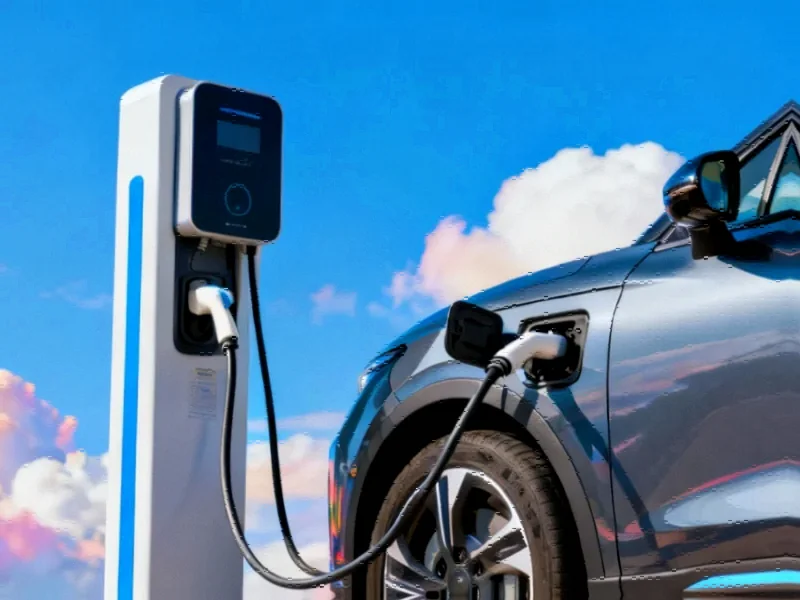Surrey’s EV Charging Infrastructure Faces Power Connection Hurdles
Surrey Council remains confident about achieving its 2028 electric vehicle charging targets despite significant delays in power connections that have left some charge point installations incomplete for months. Catherine Powell, Residents’ Association and Independent Group Leader, highlighted the ongoing issues in Farnham North, where four promised EV charge points remain non-operational despite initial installation announcements in January.
“First notification to residents they were being installed in January. Oops, that didn’t happen. Tried again in March,” Powell stated. “We’re stood here in October and there’s still just lines on the ground and a pole, no power.” The situation reflects broader challenges facing local authorities nationwide as they work to expand EV infrastructure amid growing demand.
National Grid Constraints Impact Local Implementation
Council representatives acknowledge that obtaining power connections has become the primary bottleneck in their EV infrastructure rollout. Jonathan Furniss explained: “Our particular issue with the charge points is obtaining that power connection. That has been an absolutely crucial thing, and we’re not alone in that.” The problem extends beyond recent installations, with the Merrow depot waiting “about four or five years for a connection for our EV charge points there,” forcing the council to rely on solar and battery systems instead.
These infrastructure challenges come amid broader industry developments affecting energy and transportation sectors globally. Furniss noted that UK Power Networks is “under extreme pressure across the whole country,” suggesting the connectivity issues represent a systemic challenge rather than local failure.
Utility Company Response and Alternative Solutions
Despite the delays, UK Power Networks maintains that sufficient capacity exists to support the council’s ambitions. The company stated it “continues to support all local authorities in our area deliver on their electric charging strategy and there is enough power to ensure that all chargers can be connected.” In Surrey specifically, an Independent Connection Provider has been working with the council’s charging infrastructure provider on grid connections with utility company support.
The situation highlights how market trends in sustainable infrastructure often encounter practical implementation barriers. Meanwhile, councils are exploring interim solutions, including the solar and battery backup systems already deployed at Merrow depot, demonstrating innovative approaches to circumventing grid connection delays.
Broader Context and Future Outlook
The challenges in Surrey reflect wider patterns affecting EV infrastructure development across the UK and beyond. As detailed in this comprehensive analysis of Surrey’s EV infrastructure goals, the council maintains optimism about its 2028 targets despite current obstacles. This confidence appears rooted in both the utility company’s assurances and the development of alternative power solutions.
Similar infrastructure challenges are emerging globally, with related innovations in energy and transportation facing comparable implementation hurdles. The situation underscores the complex interplay between local government initiatives, utility capacity, and the practical realities of infrastructure upgrades required for the EV transition.
Environmental policy experts note that these implementation delays occur against a backdrop of recent technology and policy shifts affecting sustainable infrastructure projects worldwide. The Surrey case demonstrates how even well-funded and planned EV initiatives can encounter unexpected bottlenecks in the transition to electric transportation.
Path Forward for EV Infrastructure
Despite the connectivity challenges, Surrey Council projects confidence in its long-term EV infrastructure strategy. The combination of utility company support, independent connection providers, and alternative power solutions suggests a multi-pronged approach to overcoming current limitations. As Furniss summarized: “I am confident that we will meet our 2028 target.”
The situation serves as a valuable case study for other municipalities planning EV infrastructure expansions, highlighting the importance of early coordination with utility providers and the development of contingency plans for power connection delays. As the 2028 deadline approaches, Surrey’s experience will likely inform best practices for EV infrastructure deployment across the UK and beyond.
This article aggregates information from publicly available sources. All trademarks and copyrights belong to their respective owners.
Note: Featured image is for illustrative purposes only and does not represent any specific product, service, or entity mentioned in this article.



